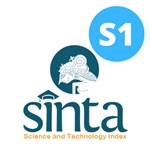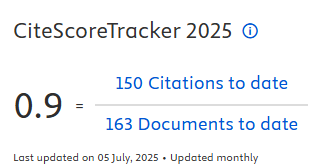RISK ASSESSMENT ALAT PRODUKSI GULA CANE KNIFE PADA STASIUN GILINGAN DI PT. X
Downloads
Industrial development in Indonesia is growing rapidly. This should be balanced with the application of good HA safety risk management to workplace hazard risks. As in PT. X Lumajang Regency, in its production process has great potential hazard. One of them is in the cane knife tool at Gilingan Station that has been damaged in operation and has an employee accident impact. Therefore, to prevent the occurrence of recurrence of risk assessment, including hazard identification, risk assessment and hazard control. The purpose of this study is to conduct risk assessment using the method of failure mode effect analysis (FMEA) on the Cane Knife production process tool in PT. X Lumajang District. This research is descriptive research. The target of this research is sugar production process at PT. X with the informant is 1 person Quality Control (QC), 1 person production operators and 1 supervisor. The results show that there are 6 (six) failure modes that occur in the cane knife tool. Based on the Risk Priority Number (RPN), the highest failure mode occurs is a broken clutch string. While for risk control, quite enough. This is because there have been risk control efforts include technical control that is the installation of safety valve, administrative control is the application of SOP for workers and personal protective equipment. But for personal protective equipment only safety helmet, for other companies do not provide. The conclusion that can be drawn is the need for better risk control, especially on the damage that occurred on the clutch rope broken tool cane knife.
Keywords: cane knife, failure mode effect analysis, risk assessment
Anwar, F.N., Ida Farida, Agus Ismail., 2016. Analisis Manajemen Risiko Kesehatan dan Keselamatan Kerja (K3) pada Pekerjaan Upper Structure Gedung Bertingkat (Studi Kasus Proyek Skyland City–Jatinangor). Jurnal Konstruksi, [e-Jurnal] 13(1): pp. 1-13
Badariah, N., Surjasa, D., Trinugraha, Y., 2012. Analisis Supply Chain Risk Management Berdasarkan Metode Failure Mode Effects Analysis (FMEA). Jurnal Teknik Industri, [e-Jurnal] 2(2): p.110–118
Bayu D., A.A., Adnyana P., I.G., Parami D., A.A., 2017. Manajemen Risiko Keselamatan dan Kesehatan Kerja (K3) pada Proyek Pembangunan Jambuluwuk Hotel & Resort Petitenget. Jurnal Spektran, [e-Jurnal] 5(1): pp. 1-9
Ghaisani, H., Nawawinetu, E.D., 2015. Identifikasi Bahaya, Penilaian Risiko dan Pengendalian Risiko Pada Proses Blasting di PT Cibaliung Sumberdaya, Banten. The Indonesian Journal of Occupational Safety and Health, [e-Jurnal] 3(1): pp. 107-116
Iswanto, A., Rambe, A.J.M., Ginting, E., 2013. Aplikasi Metode Taguchi Analysis dan Failure Mode and Effects Analysis (FMEA) untuk Perbaikan Kualitas Produk di PT. XYZ. Jurnal Teknik Industri USU, [e-Jurnal] 2(2): pp. 13-18
McDermott R. E., Mikulak R. J., Beauregard M. R., 2009. The Basics of FMEA. 2nd Edition. New York: Productivity Press
Nalhadi, A. And Rizaal, A., 2017. Identifikasi Bahaya Dan Penilaian Risiko K3 Pada Tindakan Perawatan & Perbaikan Menggunakan Metode Hirarc (Hazard Identification And Risk Assessment Risk Control) Pada PT. X. Seminar Nasional Riset Terapan (SENASSET) Serang: pp. 281-286
Nilamsari, N., 2016. Manajemen Risiko K3. Surabaya: Airlangga University Press
Pawesondra, F.Y. 2016., Faktor-Faktor yang Berhubungan dengan Kejadian Kecelakaan Kerja pada Pekerja Pabrik di Bagian pembuatan Pintu PT Corinthian Industries Kabupaten Bogor Tahun 2016. Skripsi. Depok: Fakultas Kesehatan Masyarakat Universitas Indonesia
Pradana, R.K., Dwiyanti, E., 2013. Analisis Risiko Hydrogen Recovery Unit (HRU) dan Prioritas Risiko Kegagalan Komponen Pipa Gas Hidrogen di PT. Petrokimia. The Indonesian JOurnal of Occupational Safety and Health, [e-Jurnal] 2(1): pp. 10-19
Puspitasari, N.B., Martanto, A., 2014. Penggunaan FMEA dalam Mengidentifikasi Resiko Kegagalan Proses Produksi Sarung ATM (Alat Tenun Mesin) (Studi Kasus PT. Asaputex Jaya Tegal). Jurnal Teknik Industri, [e-Jurnal] 9(2): pp. 93–98
Ramli, S., 2010. Pedoman Praktis Manajemen Risiko dalam Perspektif K3. Jakarta: Dian Rakyat
Siahaan, H., 2007. Manajemen Risiko. PT. Jakarta: Elex Media Komputindo
Sinaga, Y.Y., Cahyono, B.N., Trijoko W.A., 2014. Identifikasi dan Analisa Risiko Kecelakaan Kerja dengan Metode FMEA (Failure Mode And Effect Analysis) dan FTA (Fault Tree Analysis) di Proyek Jalan Tol Surabaya-Mojokerto. Jurnal Teknik Pomits, [e-Jurnal] 1(1): pp. 1-5
Soputan, G.E., Sompie, B.F. and Mandagi, R.J., 2014. Manajemen Risiko Kesehatan dan Keselamatan Kerja (K3) (Study kasus pada Pembangunan Gedung SMA Eben Haezar). Jurnal Ilmiah Media Engineering, [e-Jurnal] 4(4): pp. 229-238

In order to be accepted and published by The Indonesian Journal of Occupational Safety and Health, Author(s) who submit an article should complete all the review process. The copyright of received articles assigned to the The Indonesian Journal of Occupational Safety and Health and Department of Safety and Health, Universitas Airlangga as publishers of the journal. The intended copyright includes the rights to publish articles in various forms (including reprints).
The Editorial Team of The Indonesian Journal Of Occupational Safety and Health and Department of Safety and Health strive to ensure that no errors occur in the articles that have been published, both data errors and statements in the article.
Users of this website will be licensed to use materials from this website following the Creative Commons Attribution-NonCommercial-ShareAlike 4.0 International License. No fees charged. Please use the materials accordingly.
------------------------------------------------------------------------------------------------------------------------------------------------------------------------------------------
Attribution ” You must give appropriate credit, provide a link to the license, and indicate if changes were made. You may do so in any reasonable manner, but not in any way that suggests the licensor endorses you or your use.
NonCommercial ” You may not use the material for commercial purposes.
ShareAlike ” If you remix, transform, or build upon the material, you must distribute your contributions under the same license as the original.







 How to Submit Articles in OJS
How to Submit Articles in OJS

























